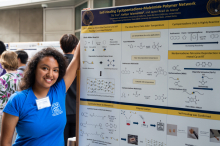
Major:
University:
Mentor(s):
Faculty Sponsor(s):
Faculty Sponsor's Department(s):
Project Title:
Project Description:
Crosslinked polymeric materials have many advantages over linear polymers such as chemical stability as well as high fracture strength, which make them superior for use in insulation, automobile tires, and structural adhesives. However, these polymers are susceptible to permanent crack formation caused by mechanical stresses. In order to reuse these materials, recent research has investigated self-healing methods using efficient chemistry. However, the repeatability of the healing can be limited by the use of catalysts. We are interested in Diels-Alder (DA) chemistry due to its thermally reversible and catalyst-free properties. By applying heat at the retro-DA (rDA) temperature, which will rearrange and heal broken bonds that occur during mechanical tearing, the crosslinked polymer can be repaired and reused. Previous methods have used anthracene and furan as dienes, and maleimide as a dienophile although the drawbacks are slow conjugation and unsuitable rDA temperature requirements. By employing cyclopentadiene (Cp) as the diene, we can increase the reaction time and apply a suitable rDA temperature (150–180 °C). Of note, Cp is highly reactive at ambient atmosphere; it tends to react with itself to form a dimer and thus, needs to be protected before the polymerization. In this case, it is protected as a norbornadiene (NBD) unit. NBD is deprotected with tetrazine in a cascade reaction to yield Cp on demand. We then reacted the Cp telechelic monomer with a maleimide crosslinker to create a crosslinked polymer. The Cp monomer and maleimide crosslinker were synthesized separately and the purity of each intermediate was checked by 1H NMR. Dynamic Mechanical Analysis was used to characterize the mechanical properties of the final polymer (e.g. glass transition temperature and storage modulus). Self-healing tests were performed at ~150 °C.
